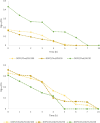Encapsulation of Olea europaea Leaf Polyphenols in Liposomes: A Study on Their Antimicrobial Activity to Turn a Byproduct into a Tool to Treat Bacterial Infection
- PMID: 39631768
- PMCID: PMC11660030
- DOI: 10.1021/acsami.4c13302
Encapsulation of Olea europaea Leaf Polyphenols in Liposomes: A Study on Their Antimicrobial Activity to Turn a Byproduct into a Tool to Treat Bacterial Infection
Abstract
According to the innovative and sustainable perspective of the circular economy model, Olea europaea leaves, a solid byproduct generated every year in large amounts by the olive oil production chain, are considered a valuable source of bioactive compounds, such as polyphenols, with many potential applications. In particular, the following study aimed to valorize olive leaves in order to obtain products with potential antibacterial activity. In this study, olive leaf extracts, rich in polyphenols, were prepared by ultrasound-assisted extraction using green solvents, such as ethanol and water. The extracts were found to be rich in polyphenols up to 26.7 mgGAE/gleaves; in particular, hydroxytyrosol-hexose isomers (up to 6.6 mg/gdry extract) and oleuropein (up to 324.1 mg/gdry extract) turned out to be the most abundant polyphenolic compounds in all of the extracts. The extracts were embedded in liposomes formulated with natural phosphocholine and cholesterol, in the presence or in the absence of a synthetic galactosylated amphiphile. All liposomes, prepared according to the thin-layer evaporation method coupled with an extrusion protocol, showed a narrow size distribution with a particle diameter between 79 and 120 nm and a good polydispersity index (0.10-0.20). Furthermore, all developed liposomes exhibited a great storage stability up to 90 days at 4 °C and at different pH values, with no significant changes in their size and polydispersity index. The effect of the encapsulation in liposomes of O. europaea leaf extracts on their antimicrobial activity was examined in vitro against two strains of Staphylococcus aureus: ATCC 25923 (wild-type strain) and ATCC 33591 (methicillin-resistant S. aureus, MRSA). The extracts demonstrated good antimicrobial activity against both bacterial strains under investigation, with the minimum inhibitory concentration ranging from 140 to 240 μgextract/mL and the minimum bactericidal concentration ranging from 180 to 310 μgextract/mL, depending on the specific extract and the bacterium tested. Moreover, a possible synergistic effect between the bioactive compounds inside the extracts tested was highlighted. Notably, their inclusion in galactosylated liposomes highlighted comparable or slightly increased antimicrobial activity compared to the free extracts against both bacterial strains tested.
Keywords: Olea europaea leaf extracts; Staphylococcus aureus; antimicrobial acitivity; liposomes; polyphenols; synergic antibacterial effect.
Conflict of interest statement
The authors declare no competing financial interest.
Figures




Similar articles
-
Ultrasound assisted extraction and liposome encapsulation of olive leaves and orange peels: How to transform biomass waste into valuable resources with antimicrobial activity.Ultrason Sonochem. 2024 Jan;102:106765. doi: 10.1016/j.ultsonch.2024.106765. Epub 2024 Jan 12. Ultrason Sonochem. 2024. PMID: 38232412 Free PMC article.
-
Solvent-Free Microwave-Assisted Extraction of Polyphenols from Olive Tree Leaves: Antioxidant and Antimicrobial Properties.Molecules. 2017 Jun 24;22(7):1056. doi: 10.3390/molecules22071056. Molecules. 2017. PMID: 28672807 Free PMC article.
-
Antioxidant and antimicrobial activities of individual and combined phenolics in Olea europaea leaf extract.Bioresour Technol. 2010 May;101(10):3751-4. doi: 10.1016/j.biortech.2009.12.052. Epub 2010 Jan 27. Bioresour Technol. 2010. PMID: 20106659
-
[Research progress on biological activities of Olea europaea leaf extract].Zhongguo Zhong Yao Za Zhi. 2016 Feb;41(4):613-618. doi: 10.4268/cjcmm20160411. Zhongguo Zhong Yao Za Zhi. 2016. PMID: 28871681 Review. Chinese.
-
Health Effects of Phenolic Compounds Found in Extra-Virgin Olive Oil, By-Products, and Leaf of Olea europaea L.Nutrients. 2019 Aug 1;11(8):1776. doi: 10.3390/nu11081776. Nutrients. 2019. PMID: 31374907 Free PMC article. Review.
Cited by
-
Impact of pharmacokinetic enhancement strategies on the antimicrobial and antioxidant activities of hydroxytyrosol.RSC Adv. 2025 Feb 3;15(5):3448-3464. doi: 10.1039/d4ra08205b. eCollection 2025 Jan 29. RSC Adv. 2025. PMID: 39902104 Free PMC article.
-
The Nanocarrier Landscape─Evaluating Key Drug Delivery Vehicles and Their Capabilities: A Translational Perspective.ACS Appl Mater Interfaces. 2025 Jul 2;17(26):37383-37403. doi: 10.1021/acsami.5c07366. Epub 2025 Jun 17. ACS Appl Mater Interfaces. 2025. PMID: 40526827 Free PMC article. Review.
References
-
- Özcan M. M.; Matthäus B. A review: benefit and bioactive properties of olive (Olea europaea L.) leaves. European Food Research and Technology 2017, 243, 89–89. 10.1007/s00217-016-2726-9. - DOI
-
- de la Rosa L. A.; Moreno-Escamilla J. O.; Rodrigo-García J.; Alvarez-Parrilla E.. Phenolic Compounds. Postharvest Physiology and Biochemistry of Fruits and Vegetables, 1st ed.; Elsevier, 2019; pp 253–271.
-
- Rispail N.; Morris P.; Webb K. J.. Phenolic Compounds: Extraction and Analysis. Lotus japonicus Handbook; Springer, 2005; pp 349–354.
-
- Rahman M. M.; Rahaman M. S.; Islam M. R.; Rahman F.; Mithi F. M.; Alqahtani T.; Almikhlafi M. A.; Alghamdi S. Q.; Alruwaili A. S.; Hossain M. S.; Ahmed M.; Das R.; Emran T. B.; Uddin M. S. Role of Phenolic Compounds in Human Disease: Current Knowledge and Future Prospects. Molecules. 2022, 27 (1), 233.10.3390/molecules27010233. - DOI - PMC - PubMed
-
- Hassen I.; Casabianca H.; Hosni K. Biological activities of the natural antioxidant oleuropein: Exceeding the expectation – A mini-review. Journal of Functional Foods. 2015, 18, 926–940. 10.1016/j.jff.2014.09.001. - DOI
MeSH terms
Substances
LinkOut - more resources
Full Text Sources
Medical
Molecular Biology Databases

